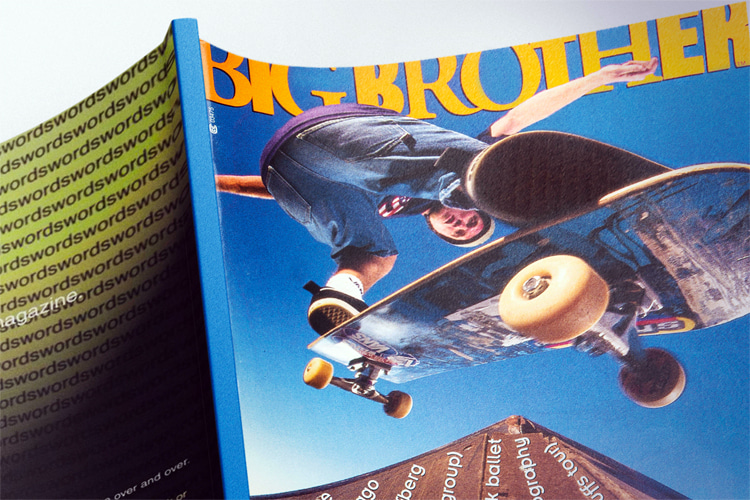If you happened to be involved in the skateboard industry circa 1991-1992, you're well aware of the fact that it needed a good swift kick in the seat of the pants - the magazines in particular.
At the time, Steve Rocco, the head of World Industries, was becoming increasingly frustrated with Transworld Skateboarding and Thrasher magazines.
This was mainly because they were refusing his ads due to content, both political and controversial.
One particular ad Transworld refused to print showed a skater committing suicide because he couldn't land a trick.
The magazines were also catering to their own self-serving interests, i.e., the obviously biased coverage of their own affiliated company's riders.
Rocco conceived the idea to create a magazine that would be entirely free from the constraints of censorship; one that would expose the behind-the-scenes idiocy in the industry; to inform the kids [about] what was "really going on" in skateboarding (if memory serves correctly, one of Rocco's quotes from this period was, "The kids have a right to know.").
In a sense, to create a "thunderdome" atmosphere where advertisers could spar with one another in a wide-open community forum.
A few of the people involved with Rocco and World Industries at the time, primarily Walter Sims and Natas Kaupas, expressed an interest in working on the magazine, so Rocco handed the project over to the two of them with a wad of cash for computers and whatnot.
Marc McKee and I were both employed as graphic artists for World Industries at the time as well, and the two of us considered the magazine to be a new toy and decided that we wanted to play also.
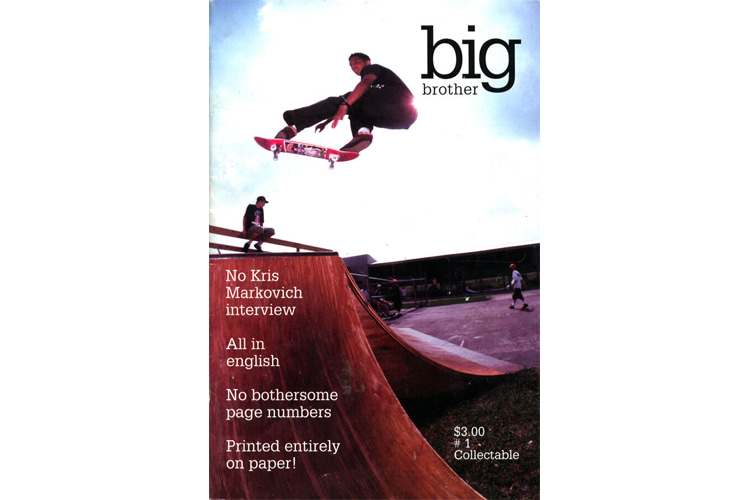
Warning: Test Copy
When the first issue of Big Brother arrived back from the printer and landed on his desk in mid-1992, Rocco couldn't believe his eyes - it looked like complete crap.
Consequently, there was a falling out between him and Walter, and one of those mutual "I quit/you're fired!' deals soon followed.
As for the 20,000 copies of Big Brother #1, Steve treated them like a red-headed stepchild. He sent every single one of them out for free to kids on the World Industries mailing list.
Hence, the first issue was chalked up as a total financial loss.
In fact, the cover contained the following sticker:
"Warning: Test Copy. Due to the fact that no one here had any idea what the in hell they were doing, this issue has been declared a total failure. Therefore, we have decided to give it away for free."
Soon after this initial debacle, Rocco hired Jeff Tremaine as the new art/editorial director and a zine kid from Lawrence, Kansas, named Thomas Schmidt, aka Earl Parker.
Jeff had previously been involved with a BMX magazine, Go, and Tom was responsible for a zine called Polyurethane Monthly.
Marc and I both stepped up our efforts from then on out as well, and Big Brother soon became one of the most notorious, volatile, and entertaining things in the skateboard industry.
People either hated it or loved it - there was no grey area - and regardless of which side of the fence you sat on, everyone made a point of reading every issue.
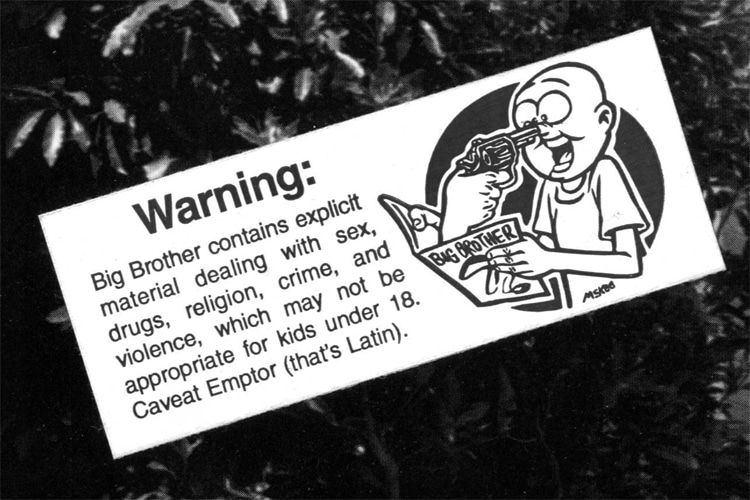
Aggressive Marketing
Right from the get-go of the second issue, it was pretty clear that Big Brother was going to be unlike any other skateboard magazine - or any other magazine directly targeted at youths - and several of the shops initially refused to carry it on moral grounds.
Rocco remained undaunted and, in turn, wielded the popularity of the World Industries brands like a sledgehammer, employing "strongarm" tactics to force the shops into carrying the magazine.
Stores would receive the ultimatum that if they didn't order 12 to 24 copies of each new issue, they would be "blackballed."
In other words, if they didn't carry the magazine, they wouldn't be allowed to carry any World products. The shops acquiesced.
Rocco remained involved with the magazine intermittently for the first seven to eight issues and was primarily responsible for instigating the gimmicks that surrounded each issue.
Marketing gimmicks were his forte.
For example, issue #2 came in an extra-large format size; issue #3 came in a spiral binding; issue #5 came with trading cards; issue #6 came in a cereal box; issue #7 had eight different covers, and issue #8 came with an audio tape to accompany the magazine's content.
These marketing gimmicks proved to be highly successful in generating interest and excitement about the magazine, but they also served to permanently sink Big Brother into a tremendous world of debt (mostly due to the cereal box) which it would never recover from.
One of the little-known facts about Big Brother is that following issue #8, Rocco had absolutely nothing to do with the magazine anymore.
He allowed Big Brother to continue despite numerous internal rifts and disputes created between the magazine and a few of the companies' sponsored pros and a continually mounting debt.
The only time Steve ever saw the magazine was when a new issue happened upon his desk.
Once Steve lost interest in the magazine, we remained resolute in our intent to make a magazine free from political interest or bias, not to mention one that celebrated the absurdist philosophy of life.
We were often castigated by several "upstanding" members of the industry, who believed that we were doing a great disservice to the sport of skateboarding, but we only sought to reflect on what was really going on in skateboarding, whatever it may be, wholesome or not, and above all - just have fun.
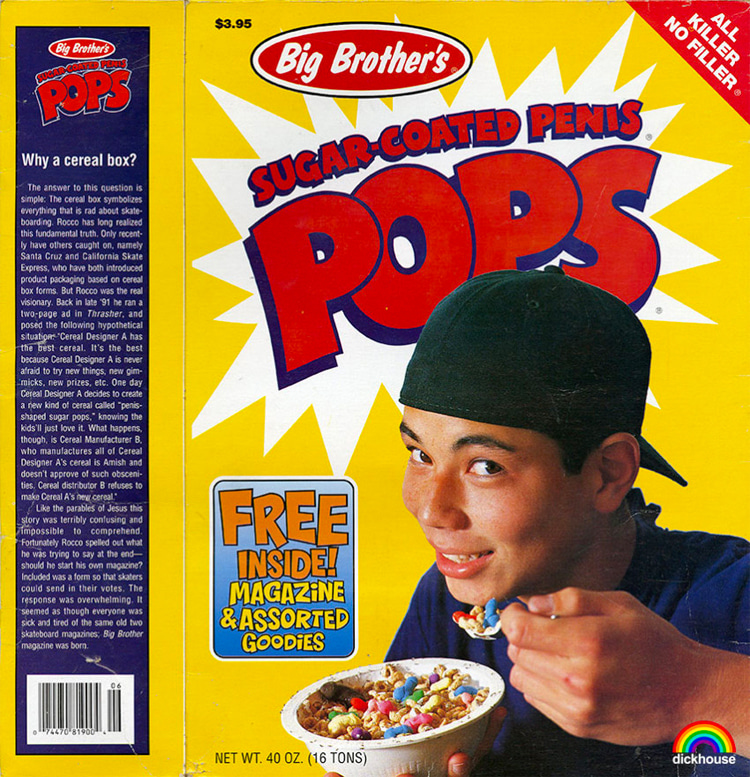
Bold Topics
In terms of outrageous content, "The How to Kill Yourself" article, which appeared in issue #3, garnered the magazine a spot on several news broadcasts, most notably in Ohio and California.
Another article that springs to mind would be the "field trip to Hustler," which appeared in issue #9 because it prominently featured a substantial amount of nudity in a magazine directly sold to minors.
This again managed to attract the interest of the news stations.
Issue #15 (aka #666) featured Steve Olson heel flipping over a stack of genuinely burning Bibles.
This upset many a reborn Christian in the skateboard world, as well as many just plain superstitious types.
The majority of the articles printed in Big Brother were composed or constructed with themes of sex, drugs, religion, midgets, alcohol, and rock 'n' roll.
Our "road trip" articles gave play-by-play accounts of very poor behavior, and we sponsored/hosted the "bong Olympics," where skateboarding's premiere pot smokers flaunted their skills with the green instead of the wood.
It should also be noted that our advertisers took full advantage of our censorship-free policy and were responsible for a good deal of controversial matters themselves, which significantly added to Big Brother's notoriety.
One of the reasons I've always respected Steve Rocco is the fact that he never let anyone tell him what he could or could not do.
And if they did, it was a direct challenge to him, which he forthrightly stepped up to accept.
As a result, pretty much anything and everything was fair game in the magazine.
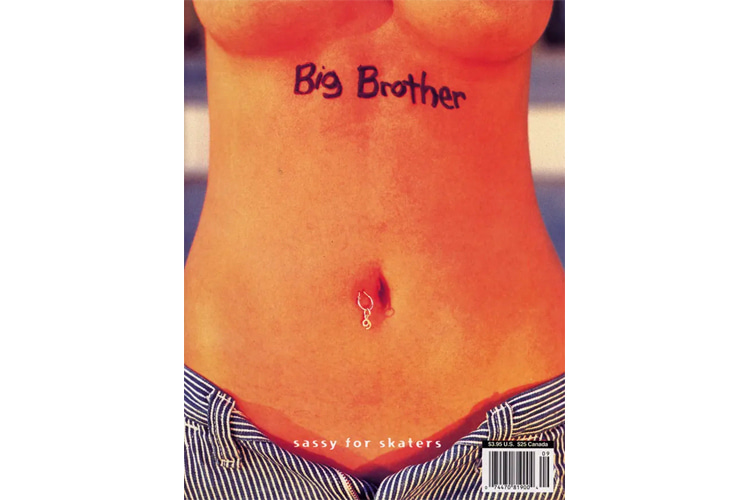
A World of Debt
Although I honestly don't know who first came up with the name "Big Brother," in all likelihood, it was Steve.
Of course, there's the obvious reference to George Orwell's book "1984," and, in a sense, I suppose this was accurate in regards to Big Brother's role in the skateboard industry.
I tend to look at it more like the magazine is a surrogate "big brother" to all the little skateboard kids out there.
Like the older sibling who shows the younger one the ropes to growing up and occasionally slips them the naughty stuff that you're not able to get on your own.
It was kind of funny, but the initial icon for Big Brother made it look more like a full-blown pederast organization than anything else - the silhouette of a young boy within that of a grown-up male within the aperture of a camera lens.
Due to the enormous expense of production, the magazine was firmly grounded in a world of debt.
By issue #25 of the magazine, I believe we had achieved a dead "breakeven point" on each issue that was produced, and even then, I'm sure there was a great deal of financial loss incurred.
One of the main problems that consistently plagued the magazine was that it didn't have a knowledgeable publisher behind it, someone who knew how to work with the newsstands and distributors.
Consequently, the magazine never achieved adequate distribution through newsstands and other outlets.
The average print run per issue ranged from only 20,000 to 30,000 copies, and people had a hard time in general just trying to find it.
A lot of this also stemmed from the fact that our content was still highly controversial at times, and shops wouldn't carry it on those grounds.
Many shops kept them behind the counter and only sold them to kids 16 or 18 years or older.
Selling Out to Larry Flynt
Larry Flynt, the publisher of Hustler magazine, came into the picture when his company, Larry Flynt Publications (LFP), was researching the possibility of acquiring a snowboard magazine.
At the time, Dickhouse Publications, our "proper" publishing name, was responsible for producing Blunt snowboard magazine as well.
Blunt was having similar problems, especially in the areas of sales and distribution.
In late 1996, LFP contacted World Industries with a proposal and later an intent to buy.
The sale was finalized in March of 1997, and the two magazines moved up into the palace of porn in Beverly Hills in April.
The funny thing is, Big Brother was merely a "consequence" of the sale. LFP primarily wanted Blunt.
Since then, Big Brother has gone on to become the more successful of the two magazines.
Many people feared the worst when they heard that Flynt had acquired the magazines, expecting their content to become even more controversial but, in fact, the exact opposite happened.
Due to Flynt's high profile, we were forced to impose new editorial guidelines (sort of).
Though the sale was some time ago, we regularly received letters condemning us for "selling out," but in all truthfulness, the choice wasn't ours to make - it was Steve's sole decision to sell the magazine.
We really didn't even have any say in the matter whatsoever, but we knew what it meant to go under the corporate thumb.
The purchase would free us of many trivial responsibilities we had.
There was only a total of six people on the payroll, all of whom pitched in on every aspect of making the magazine, from the creation to the final production.
In the end, Jeff Tremaine, Rick Kosick, Dimitry Elyashkevich, Dave Carnie, and I all made the decision to remain involved with the magazine because the basic thing is that we still have a great deal of fun working on it, and it allows us to keep the skateboard dream alive as we all roll headlong into "adulthood."
Big Brother closed its doors in 2004.
"Dumb: The Story of Big Brother Magazine" is a 2017 documentary by Patrick O'Dell on the notorious magazine's controversial history.
Words by Sean Cliver | Artist, Producer and Writer ("The Concrete Wave: The History of Skateboarding")
